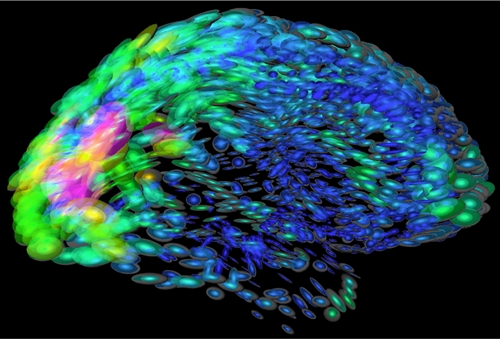17 July 2015. Engineers and medical researchers designed and tested in animals a system that implants drugs for the brain in ultra-thin optical cables, then triggers their release through wireless signals. The proof-of-concept system, developed at Washington University in St. Louis and University of Illinois in Urbana, is described in yesterday’s issue of the journal Cell (paid subscription required).
Teams from the labs of Washington University’s Michael Bruchas, professor of anesthesiology and neurobiology, and materials science and engineering professor John Rogers at Illinois, developed the technology for improving treatments of neurological disorders such as epilepsy, depression, addiction, and chronic pain. Previous efforts to deliver drugs to the brain with remote activation use hard-wired connections and tubes connected to external pumps, which limit their utility.
Like earlier attempts, the system designed by Bruchas, Rogers, and colleagues delivers therapies to precise areas of the brain where needed, enhancing their efficacy and reducing side effects. This system, however, is activated wirelessly with microscale inorganic light-emitting diodes designed to respond to infrared signals. The device is built with ultra-thin, soft cellular-scale cables containing microfluidic channels and chambers to store the compounds.
When activated, the inorganic LEDs warm a thermal-sensitive layer in the cable that expands to pump the stored compounds through the channels to adjacent brain cells. In addition to delivering drugs, the device can also transmit light signals to the brain.
Co-first author Jae-Woong Jeong, former postdoctoral researcher at Illinois and now on the engineering faculty at University of Colorado in Boulder, says in a Washington University statement, “The device embeds microfluid channels and microscale pumps, but it is soft like brain tissue and can remain in the brain and function for a long time without causing inflammation or neural damage.”
The researchers tested the devices, implanting the tiny cables in the brains of mice. Among the tests, the researchers implanted the device on one side of brain in the area of nerve cells controlling movement. Once activated, the device released a drug causing the mice to move in circles.
In a more complex test, the researchers used the photostimulation capabilities of the device to activate light-sensitive proteins that stimulate release of dopamine — a neurotransmitting chemical in the brain helping control pleasure and reward centers — in the mice’s brains while running through a maze. The dopamine release encouraged the mice to return to the same location in the maze for another reward. In the same exercise, the researchers released a chemical in the brain that interferes with dopamine receptors, thus blocking the effects of the dopamine and altering the mice’s reward-seeking behavior.
Washington University graduate student and co-first author Jordan McCall says in a university statement that the team designed the system “to exploit infrared technology, similar to that used in a TV remote. If we want to influence an animal’s behavior with light or with a particular drug, we can simply point the remote at the animal and press a button.”
Because of the device’s small size, it can be implanted with minimally invasive surgery, which expands its potential applications outside the brain, to other parts of the nervous system and other organs in the body. The researchers also believe the device can be designed to be refilled, as well as activated remotely, so it can be implanted only once and used as long as needed.
In the following interview, Bruchas and McCall tell more about the device (Courtesy, Washington University in St. Louis).
Read more:
- Magnetic Nanoparticles Found to Boost Immunotherapy
- Smart Insulin Patch Designed to Regulate Blood Glucose
- Institute Developing Engineered Bacteria for Gut Diseases
- Injectable Neuro-Electronic Wire Mesh Demonstrated
- Trial Underway Testing Sleep Apnea Stimulation Device
* * *


 RSS - Posts
RSS - Posts
You must be logged in to post a comment.